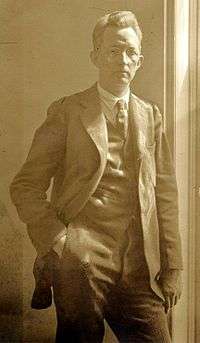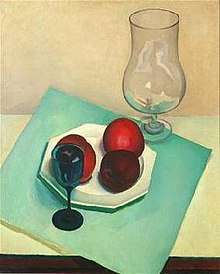Charles Sheeler
Charles Sheeler (July 16, 1883 – May 7, 1965) was an American painter and commercial photographer. He is recognized as one of the founders of American modernism, developing a "quasi-photographic" style of painting known as Precisionism and becoming one of the master photographers of the 20th century.
Charles Sheeler | |
|---|---|
 Charles Sheeler standing next to a window. c. 1910. | |
| Born | July 16, 1883 |
| Died | May 7, 1965 (aged 81) |
| Nationality | American |
| Known for | Modern art, Photography |
| Movement | Precisionism, American Modernism |
Early life and career
Charles Rettew Sheeler Jr. was born in Philadelphia, Pennsylvania. He attended the Pennsylvania Museum School of Industrial Art from 1900 to 1903, and then the Pennsylvania Academy of Fine Arts, where he studied under William Merritt Chase. He found early success as a painter and exhibited at the Macbeth Gallery in 1908.[1] Most of his education was in drawing and other applied arts. He went to Italy with other students, where he was intrigued by the Italian painters of the Middle Ages, such as Giotto and Piero della Francesca. Later, he was inspired by works of Cubist artists like Picasso and Braque[2] after a trip to Paris in 1909, when the popularity of the style was skyrocketing. Returning to the United States, he realized that he would not be able to make a living with Modernist painting. Instead, he took up commercial photography, focusing particularly on architectural subjects. He was a self-taught photographer, learning his trade on a five dollar Brownie. Early in his career, he was dramatically impacted by the death of his close friend Morton Livingston Schamberg in the influenza epidemic of 1918.[3] Schamberg's painting had focused heavily on machinery and technology,[4] a theme which would come to feature prominently in Sheeler's own work.
Sheeler owned a farmhouse in Doylestown, Pennsylvania, about 39 miles outside Philadelphia, which he shared with Schamberg until the latter's death. He was so fond of the home's 19th century stove that he called it his "companion" and made it a subject of his photographs. The farmhouse itself serves a prominent role in many of his photographs, which include shots of the bedroom, kitchen, and stairway. At one point he was quoted as calling it his "cloister." His work was also part of the painting event in the art competition at the 1932 Summer Olympics.[5]
On April 2, 1939, Sheeler (1883 – 1965) married Musya Metas Sokolova (1908–1981) his second wife, six years after the death in 1933 of first wife Katharine Baird Shaffer (married April 7, 1921). In 1942 Sheeler joined the Met museum as a senior research fellow in photography, worked on a project in Connecticut with the photographer Edward Weston, and moved with Musya to Irvington-on-Hudson, some twenty miles north of New York. Sheeler worked for the Metropolitan Museum's Department of Publications from 1942 to 1945, photographing artworks and historical objects.[6]
Sheeler painted using a technique that complemented his photography and has been described as "quasi-photographic".[7] He was a self-proclaimed Precisionist, a term that emphasized the linear precision he employed in his depictions. As in his photographic works, his subjects were generally material things such as machinery and structures. He was hired by the Ford Motor Co. to photograph and make paintings of their factories.
Photography and film work
Films created by Charles Sheeler
- 1921 Manhatta (with Paul Strand)]
Photographic works
- 1917 Doylestown House: Stairs from Below (Metropolitan Museum of Art)
- 1927 Criss-Crossed Conveyors, River Rouge Plant, Ford Motor Company (Metropolitan Museum of Art)
- 1928 Images from Vogue and Vanity Fair
Selected paintings
Early works

- Church Street El (1920) – The Cleveland Museum of Art, Cleveland
- Still Life (1925) – M. H. de Young Memorial Museum, San Francisco
- Lady of the Sixties (1925) – Boston Museum of Fine Arts, Boston
- Upper Deck (1928–1929) – Harvard Art Museum, Cambridge, MA
- American Landscape (1930) – Museum of Modern Art, New York City
- Americana (1931) – Metropolitan Museum of Art, New York City
- Classic Landscape (1931) – Barney A. Ebsworth collection
- View of New York (1931) – Boston Museum of Fine Arts, Boston
- Interior with Stove (1932) – National Gallery of Art, Washington, D.C.
- River Rouge Plant (1933) – Whitney Museum of American Art, New York City
- American Interior (1934) – Yale University Gallery, New Haven
- Ephrata (1934) – D'Amour Museum of Fine Arts, Springfield, MA
- City Interior (1936) – Worcester Art Museum, Worcester
Power series
In 1940, Fortune Magazine published a series of six paintings commissioned of Sheeler. To prepare for the series, Sheeler spent a year traveling and taking photographs. Fortune editors aimed to “reflect life through forms … [that] trace the firm pattern of the human mind,” and Sheeler chose six subjects to fulfill this theme: a water wheel (Primitive Power), a steam turbine (Steam Turbine), the railroad (Rolling Power), a hydroelectric turbine (Suspended Power), an airplane (Yankee Clipper) and a dam (Conversation: Sky and Earth) .
- Conversation: Sky and Earth (1939) – Amon Carter Museum of American Art, Fort Worth
- Primitive Power (1939) – The Regis Collection, Minneapolis
- Rolling Power (1939) – Smith College, Northampton
- Steam Turbine (1939) – Butler Institute of American Art, Youngstown
- Suspended Power (1939) – Dallas Museum of Art, Dallas
- Yankee Clipper (1939) – Rhode Island School of Design, Providence
Later works
- Interior (1940) – National Gallery of Art, Washington, D.C.
- Fugue (1940) – Boston Museum of Fine Arts, Boston
- Bucks County Barn (1940) – Terra Foundation for American Art, Chicago
- The Artist Looks at Nature (1943) – Art Institute of Chicago, Chicago
- Water (1945) – Metropolitan Museum of Art, New York
- Incantation (1946) – Brooklyn Museum, Brooklyn
- Amoskeag Canal (1948) – Currier Museum of Art, Manchester
- Windows (1952) – Hirschl & Adler Galleries, New York City
- Conversation Piece (1952) – Reynolda House Museum of American Art, Winston-Salem
- Aerial Gyrations (1953) – San Francisco Museum of Modern Art, San Francisco
- New England Irrelevancies (1953) – Boston Museum of Fine Arts, Boston
- Ore Into Iron (1953) – Boston Museum of Fine Arts, Boston
- Stacks in Celebration (1954) – Dayton Art Institute, Dayton
- Architectural Cadences Number 4 (1954) – Amon Carter Museum of American Art, Fort Worth
- Lunenburg (1954) – Boston Museum of Fine Arts, Boston
- Midwest (1954) – Walker Art Center, Minneapolis
- Golden Gate (1955) – Metropolitan Museum of Art, New York City
- Western Industrial (1955) – Art Institute of Chicago, Chicago
- The Web (1955) – Neuberger Museum of Art, Purchase, NY
- On a Shaker Theme (1956) – Boston Museum of Fine Arts, Boston
- Red Against White (1957) – Boston Museum of Fine Arts, Boston
- Composition Around White (1959) – Collection of Deborah and Ed Shein
Exhibitions
- "Charles Sheeler: Paintings, Drawings, Photographs" – Museum of Modern Art, New York, October 4 – November 1, 1939.[8]
- "Paintings by Charles Sheeler" – Dayton Art Institute, Dayton, Ohio, November 2 – December 2, 1944.[8]
- "Charles Sheeler: A Retrospective Exhibition" – Art Galleries, University of California at Los Angeles, October 11 – November 7, 1954. Toured November 18 – June 15, 1955 at the M. H. de Young Memorial Museum, San Francisco; Fine Arts Gallery of San Diego; and Fort Worth Art Center, Fort Worth, Texas; Pennsylvania Academy of the Fine Arts, Philadelphia; Munson-Williams Proctor Institute, Utica, New York.[8]
- "Charles Sheeler Retrospective Exhibition" – Allentown Art Museum, Allentown, Pennsylvania, November 17 – December 31, 1961.[8]
- "Charles Sheeler Retrospective Exhibition" - March 17 – April 14, 1963 - State University of Iowa, Department of Art.
- "Charles Sheeler" – National Collection of Fine Arts, Washington, DC, October 10 – November 24, 1968. Toured January 10 – April 27, 1969 at the Philadelphia Museum of Art, and the Whitney Museum of American Art, New York.[8]
- "Charles Sheeler: Across Media" – National Gallery of Art, Washington, DC, May 7 – August 27, 2006. Toured at the Art Institute of Chicago, October 7, 2006 – January 7, 2007; and the M. H. de Young Memorial Museum, February 10 – May 6, 2007. 50 works included, including paintings, photographs, works on paper, and a film.[9]
- "The Photography of Charles Sheeler" – Museum of Fine Arts, Boston. Toured at the Metropolitan Museum of Art, New York, June 3 – August 17, 2003; the Detroit Institute of Arts; and the Georgia O'Keeffe Museum. Nearly 100 works, including 90 photographs.[10]
- "Charles Sheeler: Fashion, Photography, and Sculptural Form", Curated by Kirsten M. Jensen, Ph.D., Gerry & Marguerite Lenfest, Chief Curator, James A. Michener Art Museum, March 18-July 9, 2017.
Notes
^ "Power: A portfolio by Charles Sheeler", Fortune magazine (December 1940) Time Inc., Volume XXII, Number 6
References
- Borland, Jennifer. Finding Aid to the Charles Sheeler Papers, circa 1840s-1966, bulk 1923-1965. Archives of American Art, Smithsonian Institution.
- Murphy, Jessica (2000). ""Charles Sheeler (1883–1965)"". In Heilbrunn Timeline of Art History. New York: The Metropolitan Museum of Art.
- Grace Glueck review of Morton Schamberg, NY Times, 1982 Retrieved August 11, 2010
- Pohald, Mark (October 2007). "Charles Sheeler: Across The Media". Exhibit Review. Chicago.Art Institute.
- "Charles Sheeler Jr". Olympedia. Retrieved August 6, 2020.
- Warren, Lynne, ed. (2006), Encyclopedia of twentieth-century photography, New York Routledge, p. 1418, ISBN 978-0-203-94338-0
- [Styles, schools and movements, published by Thames & Hudson 2002 Amy Dempsey]
- Roberts, Norma J., ed. (1988), The American Collections, Columbus Museum of Art, p. 198, ISBN 0-8109-1811-0.
- "NGA – Charles Sheeler: Across Media (5/2006)". National Gallery of Art. Archived from the original on May 9, 2011. Retrieved September 19, 2011.
- "The Photography of Charles Sheeler". Metropolitan Museum of Art. Archived from the original on August 7, 2011. Retrieved September 19, 2011.
Other links
- 1958 - Oral history interview with Charles Sheeler, 1958 Dec. 9, Archives of American Art, Smithsonian Institution
- 1959 - Oral history interview with Charles Sheeler, 1959 June 18, Archives of American Art, Smithsonian Institution
| Wikisource has original text related to this article: |
Further reading
- Brock, Charles (2006), Charles Sheeler: Across Media, Washington, D.C.: National Gallery of Art, in association with University of California Press, Berkeley, ISBN 978-0-520-24872-4.
- Friedman, Martin (1975), Charles Sheeler, New York: Watson/Guptill Publications.
- Harnsberger, R. Scott (1992), Ten Precisionist Artists: Annotated Bibliographies, Westport: Greenwood Press, ISBN 978-0-313-27664-4.
- Lucic, Karen (1991), Charles Sheeler and the Cult of the Machine, Cambridge: Harvard University Press, ISBN 978-0-674-11111-0.
- Murphy, Jessica. “Charles Sheeler (1883–1965).” In Heilbrunn Timeline of Art History. New York: The Metropolitan Museum of Art, 2000–. (November 2009)
- Rawlinson, Mark (2008), Charles Sheeler: Modernism, Precisionism and the Borders of Abstraction, London: IB Tauris, ISBN 978-1-85043-902-8.